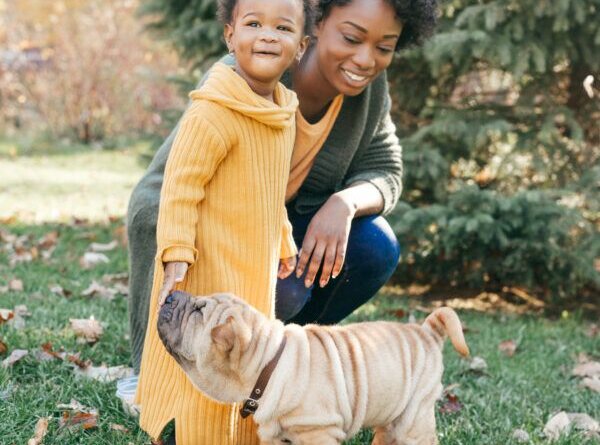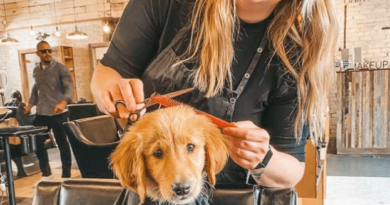How To Introduce A Dog To A Baby and Young Children – Dogster
You may envision dogs as modern-day versions of Lassie, Benji or Rin Tin Tin. In reality, most dogs need guidance navigating their relationships with children. Most dog bites to children are by dogs they know and love, so the best defense is a good offense. Dogs and kids can be best buddies if you use proper planning, thoughtful management and safety considerations.
Are all dogs good with kids?
Many dogs are good with kids and dogs are good for kids. Studies show children growing up with dogs tend to feel calmer and develop stronger bonds with friends and family.
You don’t expect dogs to be born knowing how to sit and stay on cue, so don’t expect them to know how to be gentle with babies and small children. Some breeds may be considered family-friendly, but each dog is an individual. Don’t make assumptions about your dog’s behavior. Contributing factors to how dogs might respond to kids include:
- Early socialization
- Health and wellness
- Previous interactions with babies and children
- Environment
- Preparedness for the change to their lives
- Supervision
Even if your dog is used to being around children, having a baby around 24/7 is much different. For dogs not used to being around kids, it’s especially different. For additional support, consider getting a qualified, rewards-based trainer on board to get Fido prepared for the upcoming changes.
Before bringing baby home
Plan far ahead for dog-baby bliss. First, be sure your dog has learned or brushed up on basic skills before introducing to a baby or young child: don’t try to train on the fly here. A good repertoire of solid behaviors for introductions sets boundaries and simplifies expectations.
Be sure your dog knows:
Don’t upend your dog’s world and change everything at once: set him up for success. Start building routines as soon as possible. Here’s what to do before introducing your dog to your baby. Ideally, start at least a month or two before bringing baby home. Overall keep his daily life steady. Gradually add the changes that need to happen before the big day.
If routines have been relaxed, tighten them up. Decide what Fido’s new schedule look like and begin to change it now, before the baby comes.
- If he’ll be let out/walked later in the mornings, start doing it now.
- If playtime will be restructured, in different environments or at different times, show him what that looks like.
- Reevaluate rules. Will he still be allowed on furniture? In all rooms of the house?
- Don’t wait until baby is home to bust out the new baby stuff. Get your dog used to new things by creating positive associations with them. Use treats and praise and allow him to explore at his own pace.
Show him:
- Cribs
- Strollers
- Playpens
- Toys (and the sounds they make!)
- New scents (powders, lotions, creams; also consider sending a blanket with baby’s scent on it home ahead of her arrival)
- Finally, some experts also recommend playing sounds of babies crying ahead of time to begin to acclimate your dog to that sound. Be mindful of noise sensitivity and watch for signs of discomfort. Use desensitization and graduated volume control to help Fido learn to normalize the new noise.
How to introduce a baby to a dog
Children, especially babies, can be frightening for many dogs. Kids are often loud, fast-moving, unpredictable and even rough without necessarily meaning to be. Unfortunately, all these normal behaviors can also be triggers for dogs. Understand your dog may be wary and unsure at first. Preventing stress and anxiety can help things go smoothly. Set up the environment and situation for success: management is a new parent’s BFF.
Dogs and babies should not have access to each other right away. Keep them safely apart while they get used to each other. Crates, gates, tethers or a combo of these can help facilitate positive interactions. Before baby comes home, prepare what the family-friendly organization Family Paws calls Success Stations. These get your dog comfortable near baby first without the pressure of engaging with baby.
Once your dog is clearly comfortable, and you’re ready for your active supervision role, allow your dog access to baby. Consider using a leash at first for an added safety measure. Keep interactions short and positive. Build on successes by increasing duration if your dog is calm and stress-free. If not, go back to separation and spend more time there.
Revisit your supervision and management plan often, especially when children hit milestones, such as crawling and walking, and as baby and dog both age. Certain changes in behavior can be uncomfortable for dogs.
DOs
- Have empathy: it’s a lot of pressure to accept little humans calmly and appropriately
- Always actively supervise dogs and children; they should NEVER be left together unattended
- Monitor dog’s body language and comfort level for signs of distress
- Let your dog walk away and disengage on his schedule
- Give plenty of space for kids and dogs to move around the home comfortably without being on top of each other
- Teach kids to move slowly and calmly around dogs
- Teach kids to use library voices around dogs
- Don’t encourage or allow roughhousing
- Create a safe zone for your dog where he can escape, relax and be left alone
- Show children how to pet dogs and when: pet on the chin or chest NOT the head and only if he wants to be petted (try a consent test)
- Hook up with a rewards-based trainer for not only the basics, but also additional advice for helping your dog and kids be BFFs
DON’Ts
- Allow children near dogs when dogs are eating, sleeping or engaged with their toys/bones
- Force your dog to do anything that involves baby — give your dog the choice to interact or not
- Leave dogs and children together unsupervised
- Be on your phone or making dinner or folding laundry while overseeing interactions — be present and always actively supervising
- Permit teasing, hitting, pulling/patting any part of a dog
- Let children approach dogs who are fearful, overly excited or sick
Don’t skimp on Fido’s attention once baby arrives. Show him love every day. You don’t want to him to develop negative behaviors or cultivate jealousy or resentment. Give him attention while baby’s around, not just when your baby sleeps or is out of the house. Make sure he still gets quality time alone with you, too. Always meet your dog’s needs. It’s critical that he still gets his walks, playtime, exercise and enrichment.
How do dogs know to be gentle with babies?
Dogs and babies do not necessarily instinctively know how to behave with one another. Many dogs may be gentle or even protective, but still need support on how to interact appropriately.
If you want your dog to be good around children, you must teach that. Your dog’s comfort level is key to his relationship with kids. And not all dogs love all children. Be mindful of how your kids behave around not only your dog, but also unfamiliar dogs — where supervision is again a must.
Children should never be allowed to be near or engage a dog who is:
- sleeping
- eating
- occupied with his toys
It’s natural for dogs to protect their things and their space, especially under the stress of a new arrival. Forcing interactions, being unprepared for baby’s arrival and lack of active supervision are all common denominators for trouble. Unfortunately, most children are bitten by dogs they know.
According to the “World Journal of Pediatric Surgery,” children aged 0 to 9 receive 80% of the injuries and those aged 0 to 6 account for half of those. Children under the age of 6 typically receive the severest injuries: bites to the head, face and neck (mainly due to their height) and therefore usually require the most surgeries.
We’ve all seen cute pictures and videos online of kids and dogs. But the dog may be giving clear signals he isn’t happy. Watch for this with your dog.
Subtle warnings might go unnoticed, so he’s forced to get gruff to get his message across. Maybe he snarls or growls, or even snaps. If that happens, you may be appalled and tell your dog he’s bad. But he was just trying to communicate his discomfort. So next time to avoid upsetting you, he doesn’t give the warning and bad things happen. This is a powerful and eye-opening look at both a child’s and dog’s point of view:
Advocate for safety between your child and your dog. When your dog is uncomfortable or if your child is being inappropriate, separate them immediately. Watch for these signs of distress from your dog:
- Whale eye
- Lip licking
- Shaking off
- Yawning
- Head turn
- Moving/walking away
Print this awesome guide by Lili Chin for the kids so they can also learn dog speak.
en who grow up with pet dogs enjoy numerous benefits, including: they learn responsibility, have increased self-esteem, keep more active and healthier, tend to have better immune systems and increased happiness, care and compassion.
So, Fido deserves your support in return to navigate the environmental, physical, mental and emotional changes during this new and exciting time. By taking the necessary steps to set up everyone for success you can help build bonds for a lifetime.
Resources for families:




